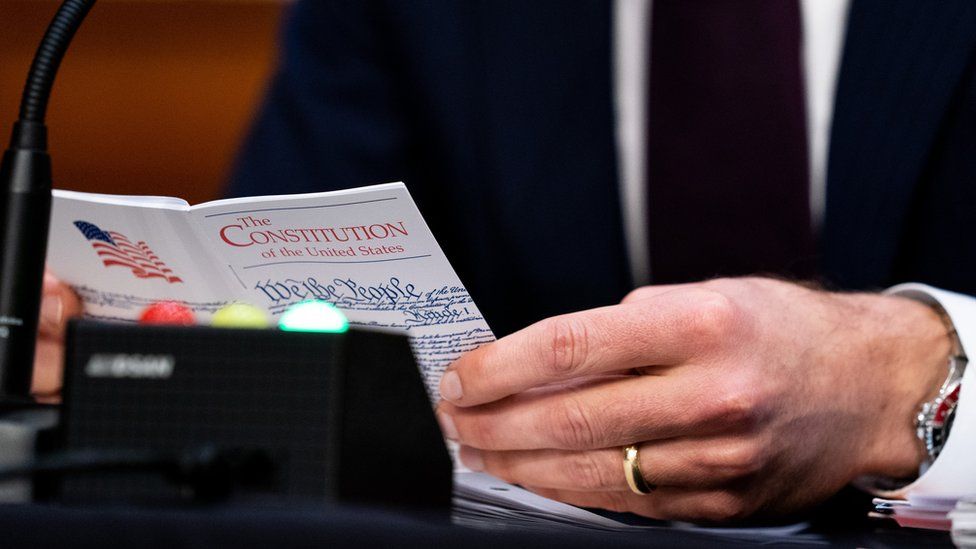Trump presidency and Capitol siege: What is the 25th Amendment?
- Published

US President Donald Trump has less than two weeks left in office, but the Senate's top Democrat has called for his presidential powers to be removed immediately after his supporters violently stormed the US Capitol on Wednesday.
"What happened at the US Capitol yesterday was an insurrection against the United States, incited by the president. This president should not hold office one day longer," Senator Chuck Schumer said in a statement.
He added that Mike Pence should invoke the 25th Amendment, which allows for a transfer of power from the president to the vice-president, either temporarily or permanently.
"If the vice-president and the cabinet refuse to stand up, Congress should reconvene to impeach the president," he said.
Democrats of the House Judiciary Committee have also written a letter to Vice-President Pence urging him to act to remove Donald Trump from office, saying he had stoked an act of insurrection and "sought to undermine our democracy".
Allow Twitter content?
This article contains content provided by Twitter. We ask for your permission before anything is loaded, as they may be using cookies and other technologies. You may want to read Twitter’s cookie policy, external and privacy policy, external before accepting. To view this content choose ‘accept and continue’.
How would this work?
The 25th Amendment allows the vice-president to become acting president when a president is unable to continue his duties, if for example, he or she becomes incapacitated due to a physical or mental illness.
The part of the amendment being discussed is section four, which allows the vice-president and a majority of the cabinet to declare President Trump unable to perform his duties.
They would need to sign a letter to the speaker of the House of Representatives and the presiding officer of the Senate declaring the president is unfit to govern or incapable "of discharging the powers and duties of his office". At this point, Vice-President Mike Pence would automatically take over.
The president is given the chance to offer a written response, and if he contests the finding, then it falls on Congress to decide. Any vote in the Senate and House of Representatives ordering the president's removal requires a two-thirds majority.
Until the issue is resolved, the vice-president would act as president.
Discussions about invoking the 25th Amendment also arose after President Trump's Covid-19 diagnosis in October last year, amid concern he may be too sick to run the country.
Around the same time, House Speaker Nancy Pelosi introduced legislation based on the 25th Amendment that created a commission to review a president's fitness for office.
Has it been used before?
The 25th Amendment was ratified in 1967, four years after the assassination of John F Kennedy, and was intended to address questions of presidential succession if a president becomes incapacitated.
And for this reason, a number of presidents have used the amendment - specifically section three - which allows them to temporarily hand over power to their vice-presidents.
In 2002 and 2007, President George W Bush placed his vice-president in charge when he was sedated during routine colonoscopies. President Ronald Reagan did the same in 1985 when he was in hospital for cancer surgery.
But to date, no sitting president has ever been permanently removed using the 25th Amendment.
What other ways could President Trump be removed from office?
There have been calls for President Trump to be impeached for a second time.
Minnesota Democratic Congresswoman Ilhan Omar announced she was drawing up articles of impeachment against him, with a growing number of fellow Democrats voicing their support.
Allow Twitter content?
This article contains content provided by Twitter. We ask for your permission before anything is loaded, as they may be using cookies and other technologies. You may want to read Twitter’s cookie policy, external and privacy policy, external before accepting. To view this content choose ‘accept and continue’.
Donald Trump has already been impeached once - by the Democrat-led House in December 2019 over allegations he improperly sought help from Ukraine to boost his chances of re-election.
He faced two charges - abuse of power and the obstruction of Congress - but was later acquitted by the Republican-led Senate.
He is only the third US president in history to have been impeached.
To impeach means to bring charges in Congress that will form the basis for a trial.
The US constitution states a president "shall be removed from office on impeachment for, and conviction of, treason, bribery, or other high crimes or misdemeanours".
It is a political process, rather than a criminal one.
It happens in two stages - articles are brought to the House of Representatives where, if passed, they proceed to the Senate for a trial.
But here, a two-thirds vote is necessary for a president's removal - and this milestone has never been reached in US history.
If President Trump were replaced through the impeachment process, Vice-President Mike Pence would move into the Oval Office.
No president has ever been impeached twice during his time in office.
Questions remain as to whether there would be enough time to impeach Donald Trump before his term ends on 20 January, when President-elect Joe Biden is inaugurated.
What does it take to impeach a president?
- Published7 January 2021
- Published7 January 2021
- Published6 January 2021
- Published5 January 2021
- Published4 October 2020
- Published23 October 2017